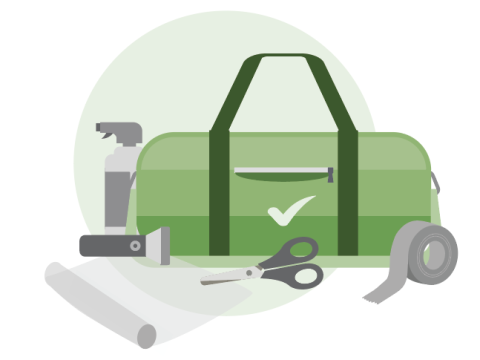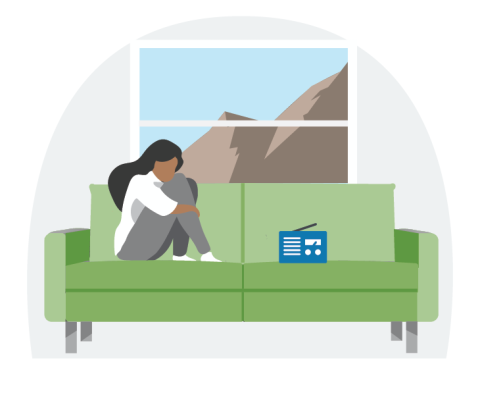Before a Landslide
During a Landslide
After a Landslide
Related Content

If you are a disaster survivor, please visit FEMA.gov for up-to-date information on current disaster declarations. If you have questions about your disaster assistance application, you can call (800) 621-3362, visit disasterassistance.gov or use the FEMA mobile app.
Landslides occur in all U.S. states and territories and can be caused by many factors including earthquakes, storms, volcanic eruptions, fire and human modifications of land. The most dangerous, life-threatening and deadliest landslides are the ones that occur quickly, often with little notice.

A landslide occurs when masses of rock, mud or debris move down a slope. When a wildfire burns a slope, it increases the chance of landslides for several years.
How to protect yourself or your property depends on the type of landslide. Land-use zoning, professional inspections, and proper design can reduce many landslide problems, but evacuation often is the only way to protect lives from a debris flow or other fast-moving landslide.
Not all landslides are fast. Some slow-moving landslides move at a snail’s pace, stopping and starting, and not advancing more than three feet a year. While these landslides rarely cause loss of life, they can cause damage to land and property over time.
Before a Landslide
The following are things you can do to protect yourself, your family and your property from the effects of a landslide or debris flow:

- Build an emergency kit.
- Make a plan for your household, including your pets, so that you and your family know what to do and where to go in the event of a landslide.
- Sign up for your community’s warning system. The Emergency Alert System (EAS) and National Oceanic and Atmospheric Administration (NOAA) Weather Radio also provide emergency alerts.
- Leave if you have been told to evacuate or you feel it is unsafe to remain in your home. Text SHELTER + your ZIP code to 43362 (4FEMA) to find the nearest shelter in your area (example: shelter 12345).
- Consult a professional for advice on appropriate preventative measures for your home or business, such as flexible pipe fittings, which can resist breakage better.
- Protect your property based on recommendations from a qualified geotechnical professional and/or local city/county guidance on protection from debris flow and flooding. You can't stop or change the path of a debris flow. However, you may be able to protect your property from floodwaters or mud by use of sandbags, retaining walls or k-rails (Jersey barriers).
- In mud and debris flow areas, consider building channels or deflection walls to try to direct the flow around buildings. Be aware, however, that when a flow is big enough, it goes where it pleases. Also, you may be liable for damages if you divert a flow and it flows on a neighbor's property.
- Talk to your insurance agent if you are at risk from a landslide. Debris flow may be covered by flood insurance policies from the National Flood Insurance Program (NFIP).
Recognize Warning Signs
Watch for debris flows and other fast-moving landslides that pose threats to life:
- If you are near a wildfire burn area, sign up for emergency alerts and pay attention to weather forecasts for the burn area.
- Listen and watch for rushing water, mud or unusual sounds.
- Unusual sounds such as trees cracking or boulders knocking together, might indicate moving debris. A faint rumbling sound that increases in volume is noticeable as the landslide nears.
- Huge boulders in the landscape can be signs of past debris flows.
Watch for slow-moving landslides, or earthflows, that pose threats to property:
- Changes occur in your landscape such as patterns of storm-water drainage on slopes (especially the places where runoff water converges) land movement, small slides, flows, or progressively leaning trees.
- Doors or windows stick or jam for the first time.
- New cracks appear in plaster, tile, brick or foundations.
- Outside walls, walkways or stairs begin pulling away from the building.
- Slowly developing, widening cracks appear on the ground or on paved areas such as streets or driveways.
- Underground utility lines break.
- Bulging ground appears at the base of a slope.
- Water breaks through the ground surface in new locations.
- Fences, retaining walls, utility poles, or trees tilt or move.
- The ground slopes downward in one direction and may begin shifting in that direction under your feet.
During a Landslide

- Listen to local news stations on a battery-powered radio for warnings.
- Always follow the instructions from local emergency managers. They provide the latest recommendations based on the threat in your community.
- Stay alert and awake during a storm that could cause a landslide. Many deaths from landslides occur while people are sleeping.
- Be aware that by the time you are sure a debris flow is coming, it will be too late to get away safely. Never cross a road with water or mud flowing. Never cross a bridge if you see a flow approaching because it can grow faster and larger too quickly for you to escape.
- If you do get stuck in the path of a landslide move uphill as quickly as possible.
- Avoid river valleys and low-lying areas during times of danger.
- If you are near a stream or channel, be alert for any sudden increase or decrease in water flow or water that changes from clear to muddy. These can be signs that a landslide is coming.
After a Landslide
- Stay away from the slide area. There may be danger coming from additional slides.
- Listen to local radio or television stations for the latest emergency information.
- Watch for flooding. Floods sometimes follow landslides and debris flows because they may both be started by the same conditions.
- Check for injured and trapped persons near the slide, without entering the direct slide area. Direct rescuers to their locations.
- Report broken utility lines and damaged roadways and railways to appropriate authorities. Reporting potential hazards will get the utilities turned off as quickly as possible, preventing further hazard and injury.
- Allow trained professionals to check the building foundation, chimney, and surrounding land for damage.
- Replant damaged ground as soon as possible since erosion caused by loss of ground cover can lead to flash flooding and additional landslides in the near future.
- Seek advice from a geotechnical expert for evaluating landslide hazards or designing corrective techniques to reduce landslide risk. A professional can advise you of the best ways to prevent or reduce landslide risk, without creating further hazard.


